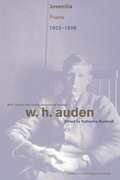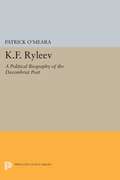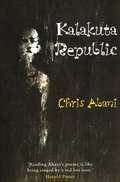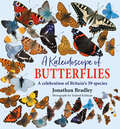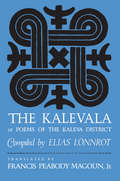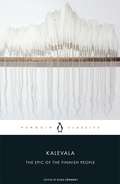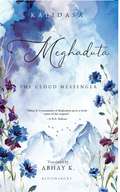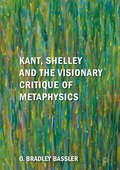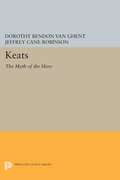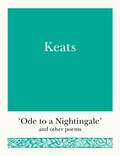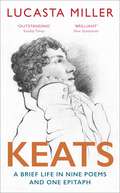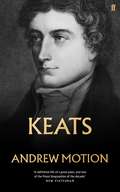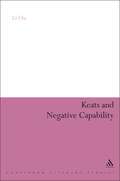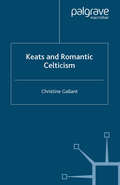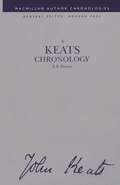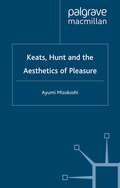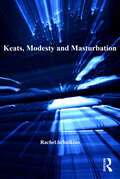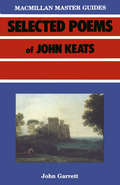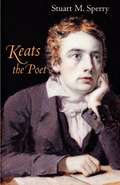- Table View
- List View
Juvenilia: Poems, 1922-1928
by W. H. Auden Katherine BucknellYou know the terror that for poets lurks Beyond the ferry when to Minos brought.Poets must utter their Collected Works, Including Juvenilia.. . .--from "Letter to Lord Byron" (1936) Regardless of how poets feel about their youthful attempts at verse, their early poems not only enrich our understanding of their artistic growth, but also reveal much about the nature of literary genius. No other twentieth-century poet has left behind such a wealth of early poetry as did W. H. Auden. By bringing together for the first time all the poems written by Auden between the ages of fifteen and twenty-one (1922-1928), this book allows us a rare, detailed look at the literary personality, development, and preoccupations of a major poet. Auden's readers will be fascinated to find in these poems the earliest evidence of his interest in psychoanalysis, his conflicted attitude toward his homosexuality, his self-conscious approach to poetry, and his life-long journey toward a religious sense of the world. This collection includes over two hundred poems, most of them never published before, concluding with the contents of Auden's privately printed volume, Poems (1928). The poems are generously annotated with information on Auden's education, reading, literary concerns, and personal life. In her introduction, Katherine Bucknell traces important themes relating to the poet's entire career, and describes crucial but hitherto unknown aspects of his youth during his years at Gresham's School and at Christ Church, Oxford. Throughout this work we see in Auden an admirable instinct for experiment, a thorough testing of tradition, and a gathering mastery of technique and thematic argument.
K.F. Ryleev: A Political Biography of the Decembrist Poet
by Patrick O'MearaThis book focuses particular attention on the six-month interrogation of the doomed poet, and it provides a critical evaluation of Soviet interpretations and an assessment of Ryleev's historical significance.Originally published in 1984.The Princeton Legacy Library uses the latest print-on-demand technology to again make available previously out-of-print books from the distinguished backlist of Princeton University Press. These editions preserve the original texts of these important books while presenting them in durable paperback and hardcover editions. The goal of the Princeton Legacy Library is to vastly increase access to the rich scholarly heritage found in the thousands of books published by Princeton University Press since its founding in 1905.
Kalakuta Republic
by Chris AbaniThis powerful collection of poems details the harrowing experiences endured by Abani and other political prisoners at the hands of Nigeria's military regime in the late 1980s. Abani vividly describes the characters that peopled this dark world, from prison inmates such as John James, tortured to death at the age of fourteen, to the general overseers. First published after his release from jail in 1991, Kalakuta Republic remains a paean to those who suffered and to the indomitable human spirit. 'Reading Abani's poems is like being singed by a red hot iron.' Harold Pinter 'Abani's poetry resonates with a devastating beauty which cuts to the heart of human strength, survival and tyranny.' Pride Magazine 'Stunning poems ... Abani conveys the experience in words shaped into art and made unforgettable by their quietness.' New Humanist 'A beautiful work of art ... elevates art and humanity above meanness and inhumanity.' World Literature Today 'A brave and challenging book ... I was moved as much by what the poems have achieved as by what they have rescued from that nightmare world. Reading, I found myself in tears.' Sunday Tribune 'An unheralded chunk of authentic literature' New Statesman 'Abani's ...poems contain moments of grace, humanity and humor.' Susannah Tarbush, Diwaniya 'Chris has emerged with poems that are graceful pieces of art, almost ready to be hung in a gallery for others to come and enter them and rest in them and weep in them and admire them.' Kwame Dawes, professor of English literature, University of Columbia, South Carolina, USA
A Kaleidoscope of Butterflies: Britain's 59 resident species
by Jonathan BradleyThere are 59 species of British butterfly and each one deserves a couple of stunning photographs, some interesting facts about its life cycle and a poem dedicated to it. Lifelong butterfly lover and poet Jonathan Bradley and his photographer friend Yealand Kalfayan have done just that in this colourful and inspiring book. Bradley has also included a mini biography of several famous lepidopterists who have left their mark in this radiant world. This lovely, bright hardback is a feast for the eyes.
The Kalevala: Or, Poems of the Kaleva District
by Elias LönnrotThe national folk epic of Finland is here presented in an English translation that is both scholarly and eminently readable. To avoid the imprecision and metrical monotony of earlier verse translations, Francis Magoun has used prose, printed line for line as in the original so that repetitions, parallelisms, and variations are readily apparent. The lyrical passages and poetic images, the wry humor, the tall-tale extravagance, and the homely realism of the Kalevala come through with extraordinary effectiveness.
Kalevala: The Epic of the Finnish People
by Elias Lönnrot'One of the great mythic poems of Europe' The New York TimesSharing its title with the poetic name for Finland - 'the land of heroes' - Kalevala is the soaring epic poem of its people, a work rich in magic and myth which tells the story of a nation through the ages from the dawn of creation. Sung by rural Finns since prehistoric times, and formally compiled by Elias Lönnrot in the nineteenth century, it is a landmark of Finnish culture and played a vital role in galvanizing its national identity in the decades leading to independence. Its themes, however, reach beyond borders and search the heart of human existence.Translated with an Introduction by Eino Friberg
Kalidasa: Meghduta The Cloud Messenger
by Abhay K.Meghaduta or The Cloud Messenger is a masterpiece of Sanskrit literature, written by Kalidasa some 1500 years ago. This breathtaking poem of 111 stanzas is about a Yaksha, who is banished for a year to central India for neglecting his duties by Kubera-the Lord of Wealth, from his abode at the fabled city of Alaka near Mount Kailasa. The Yaksha exhorts a passing cloud to carry his message across to his beloved in the Himalayas. The cloud is assisted by sylphs, nymphs, eight-legged animals, the wish fulfilling trees, drums, celestial elephants, birds, rare flowers, trees and rivers during his journey.
Kandar Anubuthi, Kandar Alangaram,Vel/Mayil/Seval Viruttham and Tiruvakuppu of Arunagiri Nathar
by Arunagiri NatharKandar Anubhuthi: In this composition of 51 verses the poet, in his inimitable style of ‘sandham’(Tune), worships Lord Murugan for protection and salvation. Kandar Alangaram: Arunagirinathar offers his favourite deity God Murugan not a garland of flowers (poomalai), but a garland of songs (paamalai) in 107 verses. It describes the different manifestations of Muruga in each temple and how He showers mercy on the devotees. Vel –Mayil-Seval Virutham: Vel is a sharp Weapon adorning the hand of God Murugan, Mayil (Peacock) is His Vehicle (Vahana) and Seval (Rooster) is His Flag. Virutham is the tempo of the lyrics. Arunagirinathar glorifies the three- Vel, Mayil and Seval, each in six viruthams.Vel is a symbol of intellect, Mayil represents splendor and majesty and Seval wakes up people from darkness to dawn.
Kant, Shelley and the Visionary Critique of Metaphysics
by O. Bradley BasslerThis book addresses the philosophy of Kant and the poetry of Shelley as historical starting points for a new way of thinking in the modern age. Fusing together critical philosophy and visionary poetry, Bassler develops the notion of visionary critique, or paraphysics, as a model for future philosophical endeavor. This philosophical practice is rooted in the concept of the indefinite power associated with the sublime in both Kant and Shelley’s work, to which the notion of the parafinite or indefinitely large is extended in this book.
Kant, Shelley and the Visionary Critique of Metaphysics
by O. Bradley BasslerThis book addresses the philosophy of Kant and the poetry of Shelley as historical starting points for a new way of thinking in the modern age. Fusing together critical philosophy and visionary poetry, Bassler develops the notion of visionary critique, or paraphysics, as a model for future philosophical endeavor. This philosophical practice is rooted in the concept of the indefinite power associated with the sublime in both Kant and Shelley’s work, to which the notion of the parafinite or indefinitely large is extended in this book.
Kapilar Akaval
by KapiladevarAkaval ia a poetic form. In this poem Kapilar narrates the mortality of life and emphasizes all are equal by birth and no one is superior by birth alone.
Keats: The Myth of the Hero
by Dorothy Bendon Van Ghent Jeffrey Cane RobinsonFocusing in a new and thoroughgoing way on Keats's widely discussed interest in Greek myth, Professor Van Ghent finds the underlying coherence in both his poetry and his letters to be archetypes of the hero and his double"--pervasive myths of creation and generation reflected in his poetics of desire.Originally published in 1983.The Princeton Legacy Library uses the latest print-on-demand technology to again make available previously out-of-print books from the distinguished backlist of Princeton University Press. These editions preserve the original texts of these important books while presenting them in durable paperback and hardcover editions. The goal of the Princeton Legacy Library is to vastly increase access to the rich scholarly heritage found in the thousands of books published by Princeton University Press since its founding in 1905.
Keats: 'Ode to a Nightingale' and Other Poems (Pocket Poets #2)
by John KeatsArguably the greatest of all the English Romantic poets, John Keats left behind him an astonishingly large body of work almost as remarkable for its maturity as for its beauty.Whether in longer narrative works like ‘The Eve of St Agnes’, or in such sonnets as ‘On First Looking Into Chapman’s Homer’, or in magnificent odes like those ‘To a Nightingale’ and ‘To Autumn’, his verse resonates with lyricism and with sensuous imagery, however melancholy his tone or his subject. His finest poems are among the greatest in the language; almost all of them strike a chord in the heart of even the most jaded reader.This compact selection includes many of Keats’s greatest shorter poems, as well as extracts from his longer works.
Keats: A Brief Life in Nine Poems and One Epitaph
by Lucasta Miller*A BOOK TO LOOK FORWARD TO IN 2021 IN THE TIMES, FINANCIAL TIMES, DAILY MAIL, SUNDAY TIMES AND GUARDIAN*The epitaph John Keats composed for his own gravestone - 'Here lies one whose name was writ in water' - seemingly damned him to oblivion. When he died at the age of twenty-five, having taken a battering from the conservative press, few critics imagined he would be considered one of the great English poets two hundred years later, though he himself had an inkling.In this brief life, Lucasta Miller takes Keats's best-known poems - the ones you are most likely to have read - and excavates their backstories. In doing so, she resurrects the real Keats: a lower-middle-class outsider from a tragic and dysfunctional family, whose extraordinary energy and love of language allowed him to pummel his way into the heart of English literature; a freethinker and a liberal at a time of repression; a human being who delighted in the sensation of the moment; but a complex individual, not the ethereal figure of his posthumous myth.Combining close-up readings of his writings with the story of his brief but teeming existence, Lucasta Miller shows us how Keats made his poetry, and explains why it retains its vertiginous originality and continues to speak to us across the generations.
Keats: Selected By Andrew Motion (Faber Poetry Ser.)
by Sir Andrew MotionKeats is the first major biography of this tragic hero of romanticism for some thirty years, and it differs from its predecessors in important respects. The outline of the story is well known - has become, in fact, the stuff of legend: the archetypal life of the tortured genius, critically spurned and dying young.What Andrew Motion brings to bear on the subject is a deep understanding of how Keats fitted into the intellectual and political life of his time. Important friendships with such anti-establishment figures as William Hazlitt and Leigh Hunt are given their full due, and the closeness of his own spirit, as expressed in his poems, to the ferment all around is made clear. Many significant new facts about Keats's schooldays and medical training, in particular, enrich the picture. Keats emerges as a more political figure than he is usually portrayed, but his personal sufferings, too, come into closer focus. Most importantly, Andrew Motion - himself a distinguished poet and former poet laureate - demonstrates how the poems continue to exert their power. 'A definitive life of a great poet, and one of the finest biographies of the decade.' New Statesman
Keats and Negative Capability (Continuum Literary Studies)
by Li Ou"Negative capability", the term John Keats used only once in a letter to his brothers, is a well-known but surprisingly unexplored concept in literary criticism and aesthetics. This book is the first book-length study of this central concept in seventy years. As well as clarifying the meaning of the term and giving an anatomy of its key components, the book gives a full account of the history of this idea. It traces the narrative of how the phrase first became known and gradually gained currency, and explores its primary sources in earlier writers, principally Shakespeare and William Hazlitt, and its chief Modernist successors, W. B. Yeats and T. S. Eliot. Meanwhile, the term is also applied to Keats's own poetry, which manifests the evolution of the idea in Keats's poetic practice. Many of the comparative readings of the relevant texts, including King Lear, illuminate the interconnections between these major writers. The book is an original and significant piece of scholarship on this celebrated concept.
Keats and Negative Capability (Continuum Literary Studies)
by Li Ou"Negative capability", the term John Keats used only once in a letter to his brothers, is a well-known but surprisingly unexplored concept in literary criticism and aesthetics. This book is the first book-length study of this central concept in seventy years. As well as clarifying the meaning of the term and giving an anatomy of its key components, the book gives a full account of the history of this idea. It traces the narrative of how the phrase first became known and gradually gained currency, and explores its primary sources in earlier writers, principally Shakespeare and William Hazlitt, and its chief Modernist successors, W. B. Yeats and T. S. Eliot. Meanwhile, the term is also applied to Keats's own poetry, which manifests the evolution of the idea in Keats's poetic practice. Many of the comparative readings of the relevant texts, including King Lear, illuminate the interconnections between these major writers. The book is an original and significant piece of scholarship on this celebrated concept.
Keats and Romantic Celticism
by C. GallantThe Celtic Revival began more than a century before Yeats and the Irish Literary Renaissance. Keats and Romantic Celtism is the first book to consider the pervasive influence of period Celticism upon Keats's work, from the Druidism that underlies his unfinished epics to the Celtic-derived folklore that his poetry draws upon. Christine Gallant shows that more than two hundred and fifty traditional folklore motifs of the faerie fill his major poems, as well as minor epistolary ones that have been critically neglected.
A Keats Chronology (Author Chronologies Series)
by F B PinionThis fully detailed chronology makes the best use of Keats's letters to indicate his poetic aims and achievements. It is supplemented by a valuable introduction and interestingly informative sketches of more than thirty persons of importance in his life. With maps and a bibliography, this work is not only an intensely intimate biography but also an exceptionally useful reference book for students and scholars.
Keats, Hunt and the Aesthetics of Pleasure (Romanticism in Perspective:Texts, Cultures, Histories)
by Ayumi MizukoshiThis book tackles the age-old interpretative problem of 'pleasure' in Keat's poetry by placing him in the context of the liberal, leisured and luxurious culture of Hunt's circle. Challenging the standard narrative which attribute Keat's astonishing poetic development to his separation from Hunt, the author cogently argues that Keats, profoundly imbued with Hunt's bourgeois ethic and aesthetic, remained a poet of sensuous pleasure through to the end of his short career.
Keats, Modesty and Masturbation
by Rachel SchulkinsExamining John Keats’s reworking of the romance genre, Rachel Schulkins argues that he is responding to and critiquing the ideals of feminine modesty and asexual femininity advocated in the early nineteenth century. Through close readings of Isabella; or the Pot of Basil, The Eve of St. Agnes, Lamia and ’La Belle Dame sans Merci,’ Schulkins offers a re-evaluation of Keats and his poetry designed to demonstrate that Keats’s sexual imagery counters conservative morality by encoding taboo desires and the pleasures of masturbation. In so doing, Keats presents a version of female sexuality that undermines the conventional notion of the asexual female. Schulkins engages with feminist criticism that largely views Keats as a misogynist poet who is threatened by the female’s overwhelming sexual and creative presence. Such criticism, Schulkins shows, tends towards a problematic identification between poet and protagonist, with the text seen as a direct rendering of authorial ideology. Such an interpretation neither distinguishes between author, protagonist, text, social norms and cultural history nor recognises the socio-sexual and political undertones embedded in Keats’s rendering of the female. Ultimately, Schulkins’s book reveals how Keats’s sexual politics and his refutation of the asexual female model fed the design, plot and vocabulary of his romances.
Keats, Modesty and Masturbation
by Rachel SchulkinsExamining John Keats’s reworking of the romance genre, Rachel Schulkins argues that he is responding to and critiquing the ideals of feminine modesty and asexual femininity advocated in the early nineteenth century. Through close readings of Isabella; or the Pot of Basil, The Eve of St. Agnes, Lamia and ’La Belle Dame sans Merci,’ Schulkins offers a re-evaluation of Keats and his poetry designed to demonstrate that Keats’s sexual imagery counters conservative morality by encoding taboo desires and the pleasures of masturbation. In so doing, Keats presents a version of female sexuality that undermines the conventional notion of the asexual female. Schulkins engages with feminist criticism that largely views Keats as a misogynist poet who is threatened by the female’s overwhelming sexual and creative presence. Such criticism, Schulkins shows, tends towards a problematic identification between poet and protagonist, with the text seen as a direct rendering of authorial ideology. Such an interpretation neither distinguishes between author, protagonist, text, social norms and cultural history nor recognises the socio-sexual and political undertones embedded in Keats’s rendering of the female. Ultimately, Schulkins’s book reveals how Keats’s sexual politics and his refutation of the asexual female model fed the design, plot and vocabulary of his romances.
Keats the Poet
by Stuart M. SperryKeats the Poet was first published in 1973, just as the crest of all the New-Critical exegeses had passed, leaving the critical literature with a wealth of fine readings, but without a real organizing program within which to view them. Stuart Sperry established such a frame of reference. Further, he did so with such prescience that even the most radical deconstructive or new historical approaches to Keats today must bear witness to their inception in Sperry's emphasis on, and subtle demonstration of, the centrality of "indeterminacy' in the poet. Now available in paperback for the first time, this work will enlighten a new generation of readers.
Keats’s Negative Capability: New Origins and Afterlives (Romantic Reconfigurations: Studies in Literature and Culture 1780-1850 #6)
In late December 1817, when attempting to name “what quality went to form a Man of Achievement especially in Literature,” John Keats coined the term “negative capability,” which he glossed as “being in uncertainties, Mysteries, doubts, without any irritable reaching after fact & reason.” Since then negative capability has continued to shape assessments of and responses to Keats’s work, while also surfacing in other contexts ranging from contemporary poetry to punk rock. The essays collected in this volume, taken as a whole, account for some of the history of negative capability, and propose new models and directions for its future in scholarly and popular discourse. The book does not propose a particular understanding of negative capability from among the many options (radical empathy, annihilation of self, philosophical skepticism, celebration of ambiguity) as the final word on the topic; rather, the book accounts for the multidimensionality of negative capability. Essays treat negative capability’s relation to topics including the Christmas pantomime, psychoanalysis, Zen Buddhism, nineteenth-century medicine, and Philip Pullman’s His Dark Materials trilogy. Describing the “poetical Character” Keats notes that “it enjoys light and shade; it lives in gusto, be it foul or fair, high or low, rich or poor, mean or elevated.” This book, too, revels in such multiplicity.
